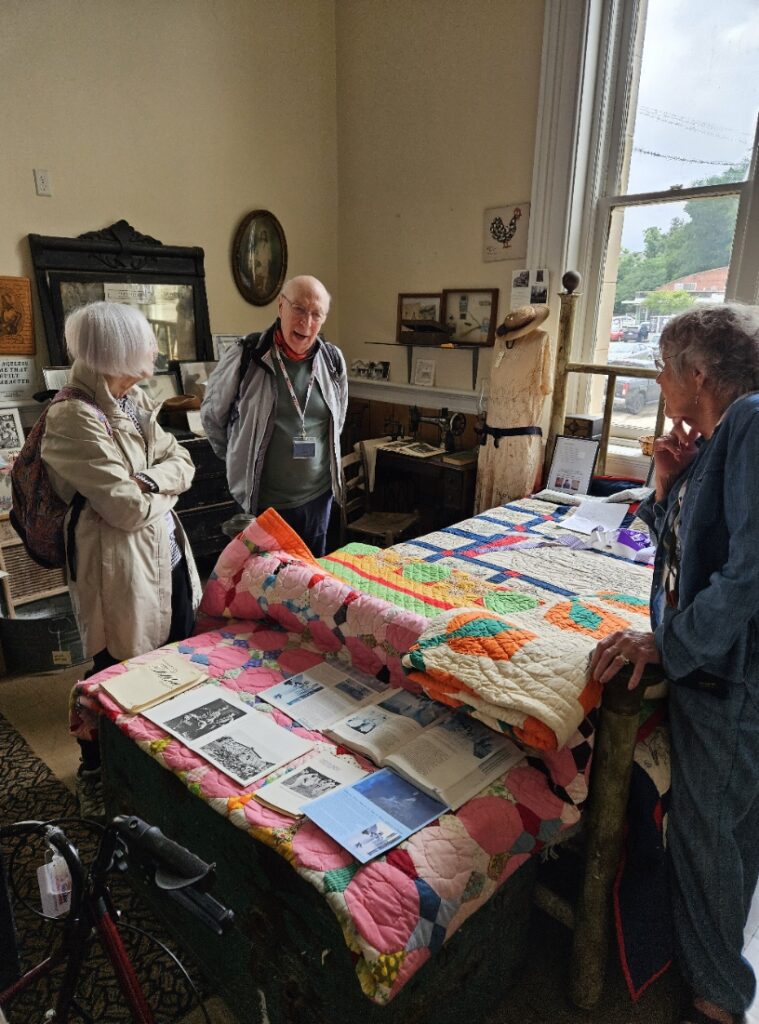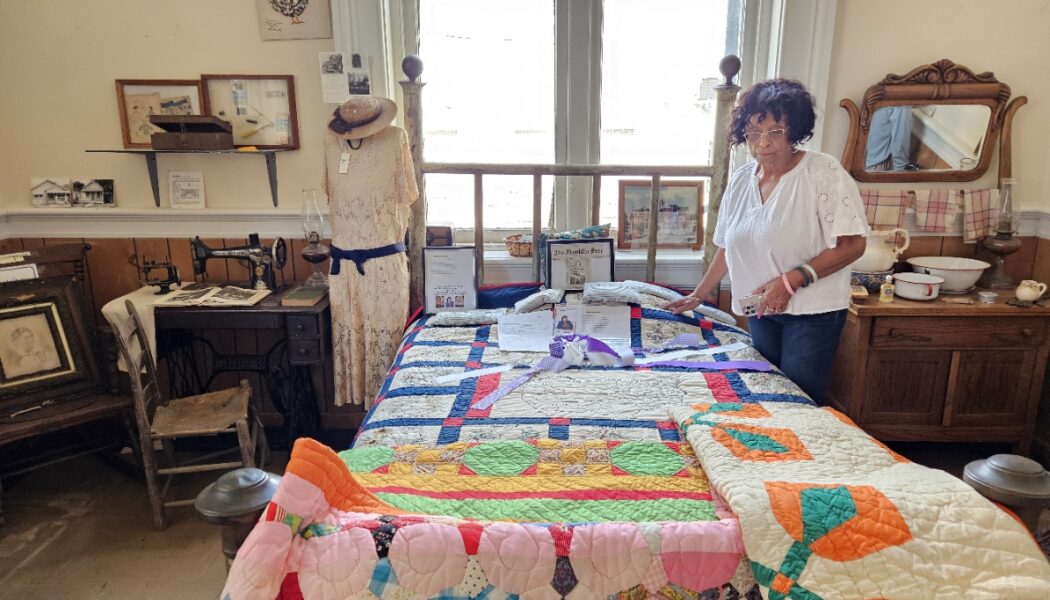Quilting among African Americans is a vibrant, living tradition. While many people are aware of quilts as decorative or utilitarian objects—bed covers, warm wraps, or heirlooms—the deeper history involves displaced cultures, coded resistance, spiritual meaning, and aesthetic innovation. In exploring the art of quilt-making, we see how African Americans have woven together fragments of fabric, memory, survival into something beautiful and meaningful.
Before the forced migration of Africans to the Americas, many societies in West and Central Africa already had rich textile arts. These include:
- Strip weaving: In places like Ghana, strips of fabric woven on narrow looms are sewn together to form larger textiles. Kente cloth (often associated with Ghana) is a classic example of this. Encyclopedia of Alabama+1
- Appliqué, patchwork, appliquéd wall hangings and tapestries: In various societies, cloth was adorned with symbolic shapes, motifs, color patterns. These designs served religious, ceremonial, social, or status-related functions. AA Registry+2texancultures.utsa.edu+2
- Color, pattern, asymmetry, improvisation: Many African textile traditions employ bold color, asymmetry, irregular geometry, broken lines, non-linear patterns; these are features that show up later in African American quilting. texancultures.utsa.edu+1
These textile traditions were not merely aesthetic; they had meaning. Symbolism—religious or spiritual, social or familial—was often encoded in motifs, colors, and styles. When people were brought to America forcibly, they carried memories of these textile arts, even if the exact tools or materials were lost.
Quilting is more than a craft. For African Americans, quilt‐making has been a deeply symbolic and functional tradition—one that binds together heritage, artistry, struggle, community, and identity. To understand its significance, we must trace its journey: from West African textile traditions, through the brutal disruption of slavery, into expressions of freedom and creativity in America.
The Transatlantic Journey and the Onset of Slavery
The Middle Passage severed many direct continuities, but enslaved persons carried intangible heritage: stories, techniques, symbolisms. Once in the American South, people from diverse ethnic groups—Mande, Yoruba, Fon, Kongo, Ewe, etc.—were forced into plantation labor, separated from kin, stripped of most material culture. Yet some textile skills survived:
- Spinning, sewing, dyeing where possible
- Making do with what was available: scraps of fabric, old clothes, sacks of flour or sugar, etc.
- Using quiltlike techniques to provide warmth and comfort, both for enslavers’ households and for their own families and cabins. Encyclopedia of Alabama+2texancultures.utsa.edu+2
This is a period of trauma, oppression, but also of cultural resilience. The textile work enslaved women did—patchwork, mending, sewing—was often invisible labor, but it maintained skills, aesthetic sensibilities, and forms of expression.
“The quilt is more than cloth. It is story, memory, survival.”

. Quilting Under Slavery: Survival, Creativity & Hybridization
Under conditions of extreme deprivation, African American quilt practice developed in ways shaped by both necessity and heritage:
- Materials: Quilts were made from worn‐out clothing, leftover fabric, work clothes, sacks, and other repurposed materials. Cotton grown by enslaved labor might be available, but finishing materials, batting, and fine fabrics were rare. Wikipedia+2Encyclopedia of Alabama+2
- Techniques: Patchwork and appliqué were central. Strip piecing, asymmetrical design, improvisation—these became part of the style. Some design elements echo African textile construction (strip weaving, broken or irregular lines). Encyclopedia of Alabama+1
- Multiple functions: Quilts were utilitarian (for warmth), communal (shared work among women and family), spiritual, commemorative. They marked life events, family memory, and sometimes resistance.
Also, there was hybridization: European colonial and American quilting styles mingled with African aesthetics. Patterns, forms, motifs that came from Anglo or European quilting practices were adopted and transformed. Enslaved people who worked in the big houses sometimes had to produce quilts for the white family; yet they also made for themselves, infusing those quilts with their traditions. texancultures.utsa.edu+2Encyclopedia of Alabama+2
- The Underground Railroad, Codes & Quilt Lore
One of the most famous—but also controversial—elements of the African American quilting story is the belief that quilts were used as coded messages along the Underground Railroad. Some accounts assert that certain quilt blocks indicated safe houses, escape routes, or instructions for fugitives. Some named patterns include the Bow Tie, Bear’s Paw, Log Cabin, etc. AA Registry+2ICMGLT+2
It is important to note that:
- The evidence for quilt codes is largely oral tradition and folklore, rather than contemporary written documentation. Some historians caution that the stories may have been embellished after the fact. Reddit+2Smithsonian Magazine+2
- Even where quilt code stories persist, they speak to the powerful idea of quilts as more than functional objects—they could be symbols, communication tools, or spiritual/emotional support.
Whether or not every claim of quilt codes is strictly historically verified, what is certain is that quilting was part of a culture of resistance—hidden meanings, spirituals, coded songs, and other forms of non-verbal communication were widespread. Quilts played a role in family memory and oral histories of escape and survival.
Emancipation, Post-Civil War and the Rise of African American Quilt Traditions
With emancipation in 1865 came new challenges—and opportunities. Freed people had more agency and some access to resources. Key developments include:
- Continuation and transformation: The quilting tradition continued, with freed women, families, and communities still making quilts for warmth, for sale, or as dowries, gifts, or community items. Patterns and techniques evolved.
- Social quilting: Quilting bees and gatherings became important; these events were social, economic, educational. Women could collaborate, share patterns, teach younger generations, and sometimes sell quilts. Encyclopedia of Alabama+1
- Materials improve (slowly): As access to factory fabrics, store-bought cloth, and more varied materials became possible, quilts began to reflect broader color palettes, finer fabrics, and more elaborate designs. But scarcity and resourcefulness remained central in many communities. Encyclopedia of Alabama+1
. The Gee’s Bend Quilters & the Freedom Quilting Bee
Two major institutions and communities highlight how quilting among African Americans developed distinct regional and communal styles, particularly in the 20th century.
Gee’s Bend, Alabama
- Origins: Gee’s Bend is a small, isolated African-American community (originally plantation land) along the Alabama River. The quilt tradition there goes back to enslaved people on the plantation; Dinah Miller, brought in 1859, is often cited as an early quilt maker whose influence persisted. Wikipedia+2National Gallery of Art+2
- Style: The quilts of Gee’s Bend are known for their improvisational designs: bold geometry, asymmetry, vivid color, unexpected composition. Because the makers used what was available—denim, old work clothing, sacks, etc.—quilt styles there developed organically, with powerful artistic impact. Wikipedia+2National Gallery of Art+2
- Recognition: Their quilts have become celebrated in museums, galleries, and exhibitions; their style has influenced broader artistic understandings of abstraction and folk art. Wikipedia+1
The Freedom Quilting Bee
- Formation: Founded in 1966 in Rehobeth, Alabama, by African-American women in Wilcox County. It was a cooperative: quilting for economic opportunity, community support, and artistic expression. Wikipedia
- Patterns and Production: The Bee’s quilts used patterns that reflect the broader Black quilt tradition: Nine Patch, Monkey Wrench, Lock and Key, etc. Many quilts were made from scraps. The Bee helped bring visibility and markets to quilts made by Black women in the rural South. Wikipedia
- Quilt as Art & the Modern Revival
In the second half of the 20th century, attention to African American quilts grew both within and beyond Black communities.
- Art exhibitions & scholarship: Quilts from Gee’s Bend and by quilters such as Harriet Powers began to be collected, studied, and exhibited in museums. Scholars such as Carolyn Mazloomi contributed significantly to collecting, documenting, and celebrating African American quilts. Smithsonian Magazine+2AA Registry+2
- Cultural pride & identity: The Civil Rights Movement, Black Arts Movement, and subsequent cultural revitalizations brought renewed interest in folk arts, African heritage, and reclaiming narrative traditions. Quilting became one avenue of reclaiming heritage and expressing identity.
Innovation: Contemporary quilters have taken old techniques and expanded on them—experimenting with new fabrics, artistic forms, symbolism, mixed media, photography, etc. Quilt art is no longer always for utilitarian or domestic use; it’s often gallery work, a political statement, or a mixed form.
. Symbolism, Design Elements & Aesthetic Features
There are several recurring features in African American quilt-making, especially as they reflect the interplay of African tradition, American necessity, and artistic innovation.
|
Feature |
Origins / Meaning |
Examples |
|
Strip piecing / strip weaving |
Reminiscent of West African strip weavings; a way to maximize fabric utility |
Bold strips joined, backgrounds, sashes. Encyclopedia of Alabama+1 |
|
Improvisation & asymmetry |
When supplies are limited and patterns are learned orally, designers adapt; also echo African aesthetics where perfect symmetry is not always the priority. |
Gee’s Bend styles; broken or irregular geometry. Wikipedia+1 |
|
Reuse of materials / repurposing |
Driven by scarcity, economic necessity; but also becomes an aesthetic and ethical choice. |
Old work clothes, sacks, corduroy, denim. Encyclopedia of Alabama+1 |
|
Symbolic appliqué & storytelling |
Biblical stories, local histories, spiritual symbolism, possibly coded messages. |
Harriet Powers’ story quilts; appliqué panels. Mama Daily+2AA Registry+2 |
|
Color & texture |
Vibrant color contrast, varied texture, creative juxtaposition; sometimes influenced by African color symbolism. |
Gee’s Bend quilts; colors of faith or mourning; contrast in sashings. AA Registry+1 |
Preservation, Scholarship & Challenges
While the tradition is strong, there have been obstacles in documenting, preserving, and crediting African American quilting history.
- Documentation: Many quilts made by enslaved people or by poor Black women in rural communities have been lost, lacked attribution, or were not preserved because they were utilitarian rather than seen as “art.”
- Recognition: For many years, the mainstream quilting world and art world undervalued Black quilts—seeing them merely as craft, or folk art, or “primitive.” Only in more recent decades have museums, galleries, and scholars begun to appreciate their artistic, cultural, and historical significance.
- Myths vs. Evidence: As noted, quilt code stories have sometimes been sensationalized; scholars debate which stories are oral tradition, which are verified history. It is crucial to approach narratives with both respect for community memory and attention to historical rigor.
- Economic and material challenges: Access to quality fabrics, funding, training, and markets can be limited, especially in rural or underserved communities. Preservation of existing quilts requires care, climate control, and sometimes considerable expense. Conclusion
The art of quilt-making among African Americans is a tapestry of resilience, creativity, and continuity. It begins in the textile traditions of West and Central Africa, survives the forced migrations and brutalities of slavery, becomes coded with meaning and resistance, evolves through freedom into a wide and diverse tradition, and today stands as both folk art and high art.
Quilts are more than beautiful objects. They are living archives of memory, faith, struggle, and identity. To see them is to witness the stories of those who stitched them: stories that might otherwise be lost. Honoring the art of quilting means honoring those stories—and the makers, many forgotten, many still working quietly with needle and thread.


